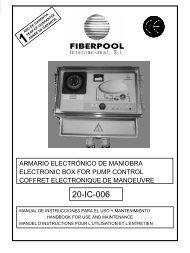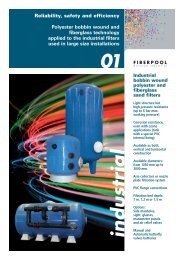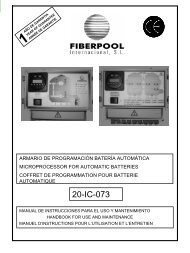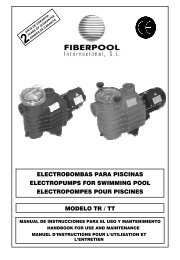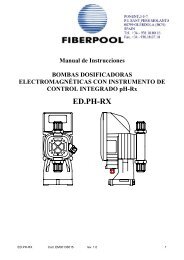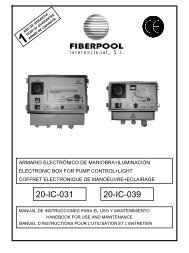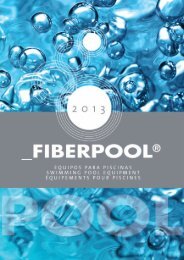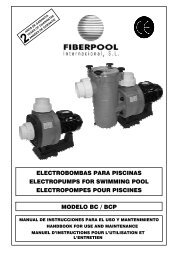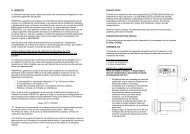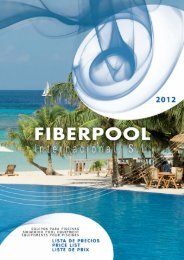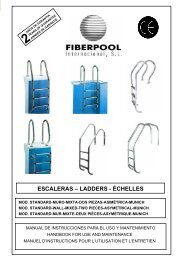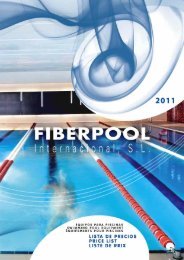BF-BB - FIBERPOOL
BF-BB - FIBERPOOL
BF-BB - FIBERPOOL
You also want an ePaper? Increase the reach of your titles
YUMPU automatically turns print PDFs into web optimized ePapers that Google loves.
<strong>FIBERPOOL</strong> INTERNACIONAL<br />
- He shall also check the condition of the contents:<br />
should this show defects which would presumably<br />
prevent correct functioning, he shall also formally<br />
notify the supplier within a period not exceeding 8<br />
days from the date of delivery.<br />
4.3 ATTENTION. Storage conditions must ensure the optimum<br />
preservation of the equipment. Due to its particular relevance,<br />
we must stress that very damp atmosphere or others where<br />
brusque changes in temperatures (which cause condensation)<br />
must be avoided.<br />
5. INSTALLATION AND ASSEMBLY<br />
5.1 Location. ATTENTION. The place where the electropump<br />
is to be located must be dry. In all events, there must be a<br />
drain in the floor as prevention against flooding. If the pump is<br />
to be located in a damp place, a ventilation system must be<br />
provided in order to prevent the formation of condensation. In<br />
case of very confined areas, cold air can reach a low<br />
temperature which requires a ventilation system where by the<br />
atmospheric temperature does not exceed 40ºC. It's important<br />
for there to be sufficient space to permit the motor block to be<br />
dismounted horizontally and the hair filter vertically (see<br />
minimum space diagram in fig. 1, page 11).<br />
5.2 Positioning /installation<br />
ATTENTION. The equipment or set of motor pump, filter and<br />
selection valve, will be installed near the swimming pool at a<br />
distance of no more than 3 m, from the surface skimmers and<br />
preferably at the level of 0.5m (never more that 3m) below the<br />
level of the water in order to achieve its “under load”<br />
functioning. The selection valve junction, and its connection to<br />
the nozzle and other accessories incorporated in the swimming<br />
pool will preferably be made in PVC casing. Pipe diameters will<br />
depend on flows. The maximum water speed advisable in the<br />
pipes will be 1.2 m/s in aspiration and 2 m/s on return. In any<br />
event, the diameter of the aspiration of the aspiration pipe<br />
must not be less than diameter of the pump nozzle. The<br />
aspiration pipe must be perfectly watertight and must be<br />
installed with a downward inclination, thus avoiding the<br />
formation of air pockets. In permanent installations, with the<br />
pump positioned at a higher level than that of the water, it is<br />
advisable for the longest stretch of the aspiration pipe to be<br />
below the plans mentioned until it reaches the vertical pipe<br />
which coincides with the pump aspiration shaft. The aspiration<br />
pipe can be either rigid or flexible with a reinforced coil to avoid<br />
contraction.<br />
In fixed installations, with the pump below the water level, a<br />
shut-off valve will be placed on the aspiration pipe and another<br />
on the header pipe.<br />
ATTENTION. When using as a portable pump,<br />
suitable electrical protection must be provided and the pump<br />
must be assembled on an insulated base.<br />
5.3 Connections to the mains.<br />
ATTENTION. In general terms, the electrical installation will<br />
fully comply with the Regulations and Complementary<br />
Technical provisions applicable and will be performed by an<br />
authorised Installer. The supply will have neutral and earth<br />
wires. The mains voltage must correspond to that shown on<br />
the nameplate rating for the equipment. The earth wire to be<br />
used must be sufficient to take, without deterioration, the<br />
current absorbed by the equipment (see nameplate). The<br />
mains earth wire will be connected electrically to all metal parts<br />
of the equipment which should not be under current, but which<br />
could accidentally be affected by the same and which are<br />
accessible to persons (see figs.4,5 page 11-12).<br />
It is obligatory to install a protection and operation switchboard,<br />
which will contain all necessary and recommended elements.<br />
In general terms, it will contain:<br />
a. General cut-off or unipolar switch.<br />
b. Short-circuit and overload protection devices for<br />
motors.<br />
c. 30mA differential high sensitivity switch.<br />
d. Others for monitoring and control.<br />
The electrical characteristics of the protection devices and their<br />
regulation will comply with those for these, and the instructions<br />
given by the manufactured must be (see nameplate).<br />
- In the case of equipment with triphase motors, the<br />
motor winding interconnection bridges must be<br />
suitably positioned (see figs 4-5, page 12).<br />
- Conductor inlets and outlets at the bushing box will<br />
have stuffing to ensure the absence of damp and dirt,<br />
and will therefore have a sealed casing.<br />
- Conductors will have suitable terminals for connection<br />
to the bushings.<br />
6. STARTING<br />
Before connecting the equipment to the Mains, the<br />
following operations will be carried out:<br />
- Check that the electrical conditions are correct.<br />
- Manually check that the motor pumps not jammed.<br />
6.1 Pump priming. ATTENTION.<br />
The electro-pumps <strong>BF</strong>-<strong>BB</strong> are not self-priming.<br />
Avoid blind functioning of the electropump.<br />
With the pump in the aspiration (above the water level of the<br />
swimming pool). Before starting, remove the pump casing<br />
cover (page 14 nº2) and slowly fill with clean water up to the<br />
level of the aspiration nozzle. Close the cover (2) again and<br />
take care that it is hermetically closed.<br />
ATTENTION. With the pump below the swimming pool<br />
water level always with the cover hermetically closed, fill the<br />
pump by slowly opening the aspiration cut-off valve, with the<br />
header valve in the open position.<br />
6.2 ATTENTION.<br />
The pump must not be started without the lumps and hair filter<br />
(page 14 nº4) since this could cause obstruction and would<br />
block the system.<br />
6.3 Direction of rotation. ATTENTION.<br />
Ensure that the motor shaft turns freely; do not start the pump<br />
if is blocked. For this purpose, electropumps have a groove at<br />
the end of the shaft, on the ventilator side, which permits it to<br />
be turned manually using a screwdriver (fig 1 page 11 ).<br />
In triphase motors, the impeller, (page 14 nº8) can be<br />
unscrewed if the motors starts in the opposite direction.<br />
Counter-rotation can even damage the mechanical seal. Start<br />
the motor for a few seconds and check that the direction of<br />
rotation coincides with that indicated by the arrow on the<br />
ventilator cover. Should this not be the case, it is absolutely<br />
necessary to advise the authorised installer (invert the phase<br />
connection).<br />
6.4 ATTENTION.<br />
6



